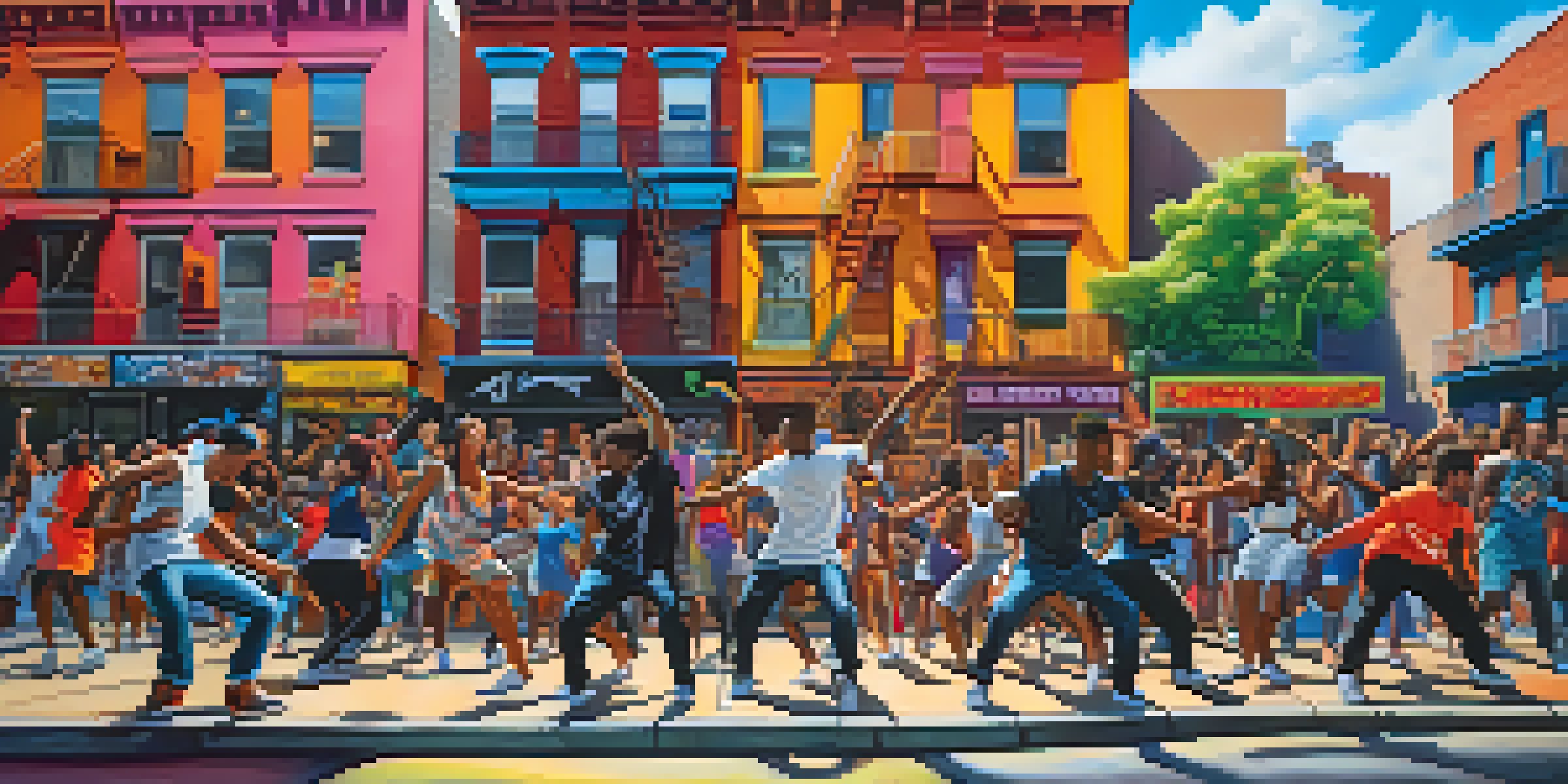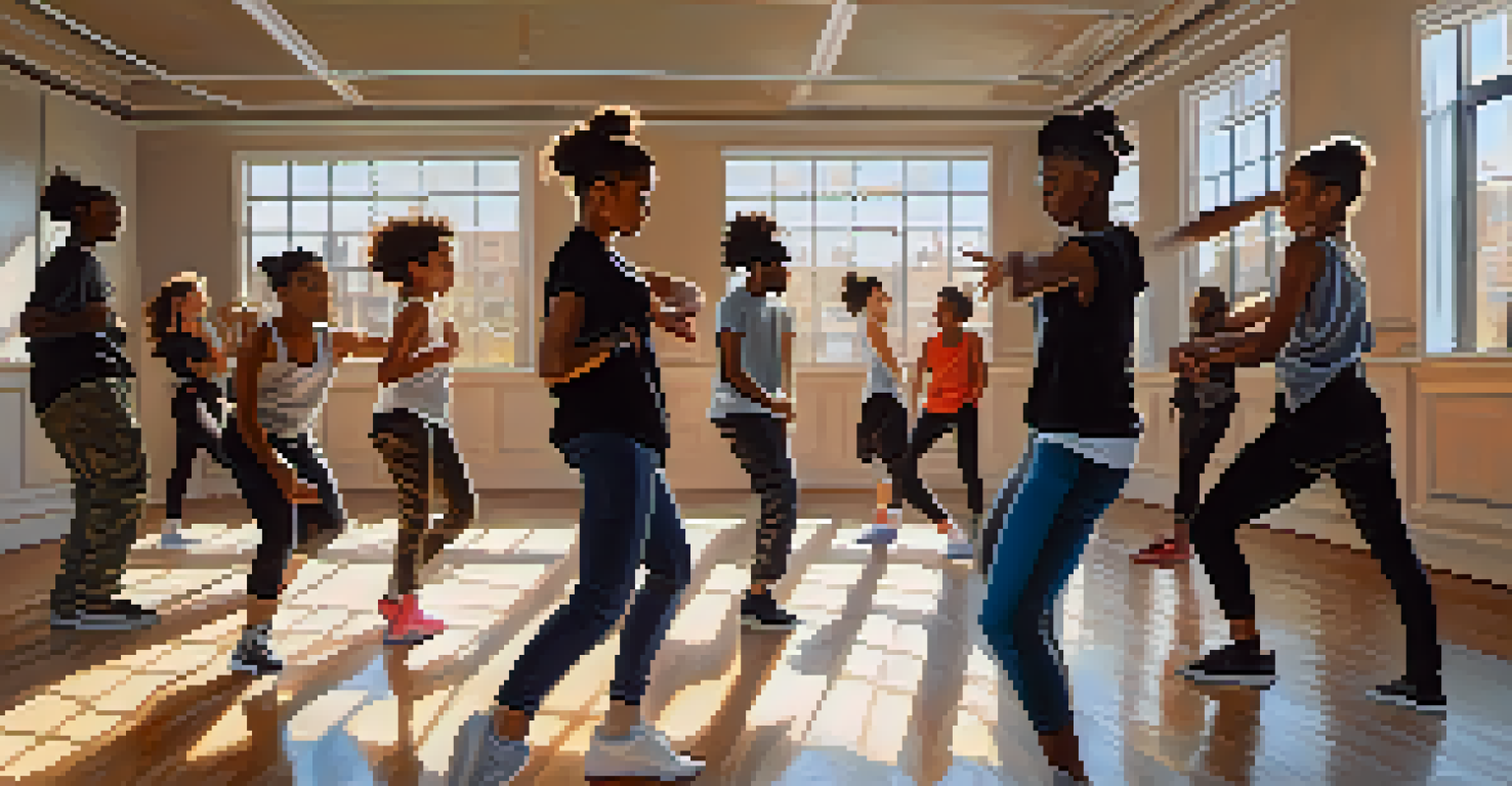Hip-Hop Dance as a Voice for Marginalized Communities

The Origins of Hip-Hop Dance and Its Cultural Significance
Hip-hop dance originated in the late 1970s in the Bronx, New York, emerging as a vibrant form of expression among African American and Latino youth. It was more than just a dance style; it was a cultural movement that represented the struggles, hopes, and dreams of marginalized communities. This dance genre captured the essence of street life and became a voice for those often unheard.
Hip hop is not just a genre; it’s a lifestyle, a culture that reflects the experiences and expressions of marginalized communities.
As hip-hop dance evolved, it incorporated various influences, including African dance, jazz, and breakdancing. Each movement told a story, reflecting the social dynamics and issues faced by the dancers. In essence, hip-hop dance became a narrative tool, allowing individuals to express their personal and collective experiences through rhythm and movement.
Today, hip-hop dance maintains its roots while also branching out into mainstream culture. Despite its commercialization, the dance continues to serve as a powerful medium for storytelling, fostering connection and understanding among diverse audiences.
Dance as a Form of Resistance and Empowerment
For many marginalized communities, hip-hop dance serves as a form of resistance against societal injustices. It allows dancers to reclaim their narratives and challenge stereotypes, showcasing their talent and resilience. This art form becomes a powerful way to voice dissent and articulate the struggles faced by these communities.

Through dance battles, performances, and community gatherings, hip-hop dancers create spaces where they can express their frustrations and aspirations. These events often celebrate unity and solidarity, reinforcing the idea that dance is not just an art but a movement for change. The rhythm of the music and the energy of the dance create a collective spirit that inspires participants and audiences alike.
Hip-Hop Dance as Cultural Expression
Hip-hop dance emerged as a powerful form of expression for marginalized communities, reflecting their struggles and dreams.
Moreover, hip-hop dance empowers individuals by instilling confidence and fostering a sense of belonging. For many, it provides an opportunity to escape daily challenges and channel their emotions into something beautiful and impactful.
The Role of Hip-Hop Dance in Community Building
Hip-hop dance plays a crucial role in building community among marginalized groups. Dance studios, workshops, and local events become safe havens where individuals can come together, share their stories, and nurture their passion for dance. These spaces cultivate a sense of belonging that is often missing in their everyday lives.
Dance is the hidden language of the soul.
Through collaboration in dance, individuals learn to trust and support one another, breaking down barriers of isolation and fear. This community spirit fosters creativity and innovation, leading to the development of new dance styles and forms of expression. As dancers share their unique perspectives, they enrich the cultural tapestry of hip-hop.
In many cases, these communities extend beyond just dance, creating networks of support that address various social issues, from education to mental health. By uniting through hip-hop dance, marginalized individuals find strength in numbers and the courage to advocate for broader social change.
Hip-Hop Dance and Identity Formation
For many dancers, hip-hop dance is a vehicle for exploring and expressing their identities. It allows individuals to showcase their cultural backgrounds, personal stories, and unique styles through movement. This exploration fosters a deeper understanding of self and community, empowering individuals to embrace their roots.
Moreover, hip-hop dance challenges conventional notions of identity, inviting dancers to experiment with various styles and influences. This fluidity encourages participants to break free from societal expectations and express their authentic selves. In a world where identity can often feel constrained, hip-hop dance offers a liberating space for exploration and expression.
Community Building Through Dance
Hip-hop dance fosters community by providing safe spaces for individuals to share stories, collaborate, and support one another.
As dancers share their stories through movement, they contribute to a larger narrative that celebrates diversity and resilience. This process of identity formation not only enriches the dance community but also inspires others to embrace their uniqueness and find their voice.
The Global Impact of Hip-Hop Dance on Marginalized Communities
Hip-hop dance has transcended borders, influencing marginalized communities worldwide. From Brazil to South Africa, dancers have adopted hip-hop as a means of self-expression and social commentary, reflecting their unique cultural contexts. This global phenomenon demonstrates the universal appeal of hip-hop as a language of movement and a catalyst for change.
As diverse communities embrace hip-hop dance, they create their interpretations, blending local traditions with hip-hop influences. This fusion enriches the global hip-hop culture, showcasing the creativity and resilience of marginalized groups everywhere. The shared language of dance fosters connections across cultures, uniting individuals through their shared experiences.
Furthermore, the global reach of hip-hop dance has led to increased visibility for marginalized issues, amplifying voices that often go unheard. Through international competitions and collaborations, dancers can advocate for social justice, raising awareness about the challenges faced by their communities.
Educational Programs and Hip-Hop Dance
Educational programs incorporating hip-hop dance have emerged as powerful tools for empowerment among marginalized youth. These initiatives often prioritize creativity and self-expression, offering a safe space for students to explore their talents. By engaging with hip-hop dance, young people can develop confidence and critical thinking skills.
Many programs also emphasize the importance of cultural history, teaching participants about the origins and evolution of hip-hop dance. This knowledge fosters a sense of pride in their cultural heritage, encouraging students to appreciate the richness of their backgrounds. Education through dance becomes a holistic experience, encompassing both artistic development and personal growth.
Empowerment Through Education
Educational programs incorporating hip-hop dance empower youth by promoting creativity, cultural pride, and social advocacy.
In addition to dance skills, these programs often address social issues that affect marginalized communities, such as poverty, violence, and discrimination. By combining dance with social education, participants are empowered not only as artists but also as advocates for change within their communities.
The Future of Hip-Hop Dance as a Voice for Change
As hip-hop dance continues to evolve, its potential as a voice for marginalized communities remains strong. Dancers and choreographers are increasingly using their platforms to address social issues, pushing for greater awareness and justice. The ongoing dialogue within the dance community reflects a commitment to using art as a means of advocacy.
Emerging technologies, such as social media and digital streaming platforms, have further amplified the reach of hip-hop dance. Dancers can now share their stories and performances with a global audience, sparking conversations about social justice and cultural representation. This accessibility has the power to inspire and mobilize individuals around the world.

Looking ahead, the future of hip-hop dance lies in its ability to adapt and innovate while staying true to its roots. As long as there are stories to tell and voices to uplift, hip-hop dance will remain a vital force for change and empowerment in marginalized communities.